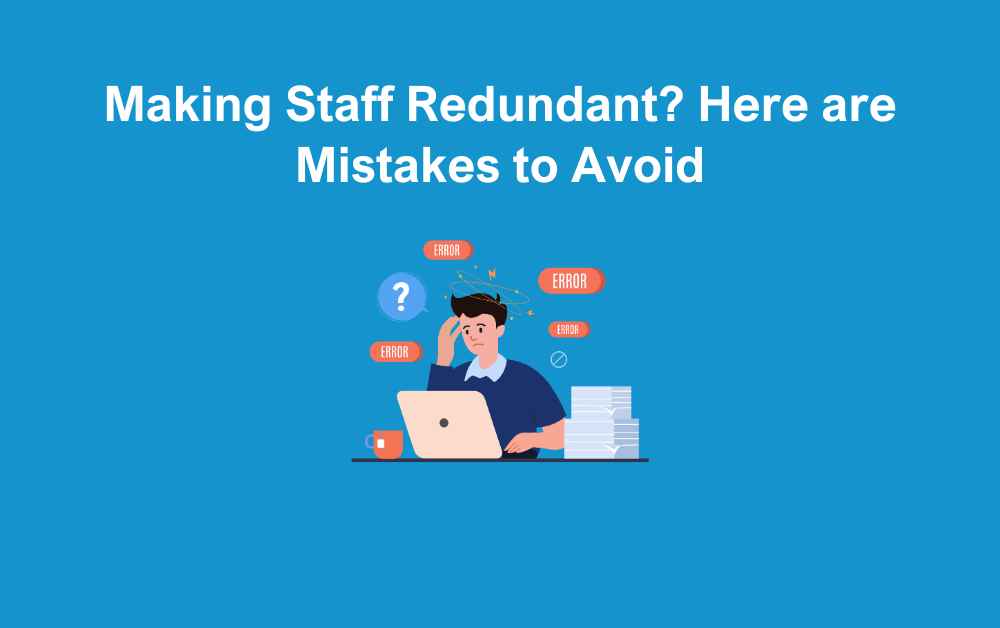Unfair Redundancy Selection Criteria
Failing to follow fair redundancy selection criteria is one of the most common and damaging mistakes an employer can make. Using subjective or discriminatory redundancy selection criteria is a critical mistake when making staff redundant that can lead to legal claims and damage to employee trust.
Criteria should be clear, objective, and based on business needs, not personal opinions or bias. For example, basing decisions on performance reviews is acceptable if these are recent and well-documented, while making selections based on age, gender, or other protected characteristics is unlawful. A fair process ensures compliance with employment law, protects your reputation, and helps retain key talent.
Examples of fair redundancy selection criteria include:
- Performance
- Absence records
- Disciplinary records
- Time Keeping
- Knowledge/experience
Find out how to follow the correct procedure when it comes to redundancy selection criteria.
Skipping the consultation process
It is a legal requirement to consult with your employees who are at risk of being made redundant. Failing to consult properly when making staff redundant can lead to claims of unfair dismissal and financial penalties. Key reasons for a consultation include:
- Discussing the reasons for redundancy
- Explore possible alternatives
- Consider employee feedback and suggestions
For collective redundancies (20 or more employees within 90 days), employers must follow collective consultation rules. This includes:
- Notify the Redundancy Payments Service (RPS) using the HR1 form. Deadlines vary based on the number of redundancies proposed.
- Consult with trade union or elected employee representatives, or directly with employees if no representatives are in place.
- Provide clear, detailed information about the planned redundancies, allowing time for review and consideration.
- when making staff redundant, respond to any follow-up questions or requests for additional information.
- Issue termination notices to affected employees, including the agreed leaving date, after the consultation is complete.
- Formally issue redundancy notices to finalise the process.
Not considering alternatives to redundancy
Redundancy should always be a last resort. By considering alternatives, you may find solutions that protect jobs while addressing your business challenges. Key alternatives to redundancy include:
- Redeployment or secondment
- Reducing hours
- Job share
- Pause on recruitment
- Early retirement
- Overtime Freeze
By engaging with employees and representatives to explore these options, you can demonstrate a commitment to fairness and minimise the negative impacts of workforce reductions. This approach not only protects jobs but also strengthens your organisation’s reputation and resilience.
Not asking for feedback
A big mistake that a lot of employers make when making staff redundant is not taking feedback on board.
Consultation is not just a legal requirement but also an opportunity for open dialogue. Employees often have valuable insights into the business and may propose ideas, such as cost-saving measures or redeployment options, that could reduce the need for redundancies. Ignoring or dismissing this feedback can make the process feel one-sided and unfair, increasing dissatisfaction and the likelihood of grievances or tribunal claims.
By actively listening to employees and considering their suggestions, employers can demonstrate respect, build trust, and potentially identify alternative solutions that benefit both the business and its workforce. A collaborative approach when making staff redundant not only ensures compliance but also fosters a more positive working environment during a challenging time.
Calculating redundancy pay incorrectly
Currently, if an employee has worked for your business for two years or more, they are entitled to statutory redundancy pay. The final amount they will receive is based on age, length of service, and weekly wage. You can find out how to calculate redundancy pay in our latest article.
Even if you have miscalculated an employees redundancy pay by mistake, they can still accuse you of unfair dismissal. Therefore, it’s crucial that you put everything in place to avoid any mistakes when making staff redundant. If you would like help with this, you can contact our HR experts.
Not Considering Voluntary Redundancy
When facing workforce reductions, bypassing voluntary redundancies in favour of compulsory measures can lead to unnecessary challenges. Voluntary redundancies offer employees the choice to leave on their terms, reducing resistance, preserving morale, and minimising disputes. It allows those ready to move on to exit while retaining employees who are committed to staying, ensuring the organisation retains key talent and expertise. Additionally, voluntary redundancies often come with fewer risks of legal challenges, potentially reducing costs compared to compulsory redundancies.
Do You Need Help With Redundancies?
Making staff redundant is never an easy task, but it is sometimes necessary during challenging times. Mishandling redundancies can lead to costly mistakes, legal repercussions, and damage to your company’s reputation.
At The HR Booth, we understand the complexities involved in managing redundancies. With decades of combined experience, our HR experts are here to guide you through the process, helping you avoid common mistakes and ensuring a fair, legal, and empathetic approach.
Our services include:
- Fair Redundancy Selection Criteria: Developing objective, lawful criteria to protect your business.
- Consultation Support: Navigating the consultation process to ensure compliance and build trust.
- Alternative Solutions: Exploring options to reduce redundancies while retaining talent.
- Redundancy Pay Assistance: Ensuring accurate calculations to avoid disputes.
- Voluntary Redundancy Advice: Minimising resistance and maintaining morale.
Making staff redundant is a hard decision to make. However, with the right support, it doesn’t have to be a confusing or stressful process. Learn more about our redundancy services by contacting us on 01383 668178. We look forward to answering any remaining questions you may have.
Redundancy FAQ’s
1. What is a drawback of making staff redundant?
A drawback of making staff redundant is the potential loss of valuable skills and experience, which can negatively impact organisational performance and morale.
2. What are the 5 stages of redundancy?
The first five stages of redundancy are planning, selection, consultation, notice of redundancy, and appeals. Find out the full redundancy process in our dedicated blog post.



